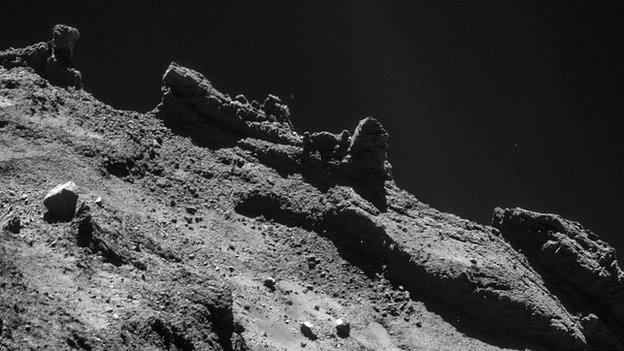Comet yields 'rich array' of organics
- Published
- comments

The spacecraft which made a spectacular landing on a comet last year has discovered a rich array of carbon compounds.
One leading scientist has even described the chemicals as "a frozen primordial soup".
This supports the theory that comets may have seeded the early Earth with the ingredients for life.
The findings came after the lander, known as Philae, touched down on comet Churyumov-Gerasimenko 67P in November.
It was dropped by the European Space Agency's Rosetta "mothership" in the climactic stage of a ten-year mission.
Results from the lander's seven instruments are published in a special collection of papers in the journal Science.
One team running a device called COSAC found no fewer than 16 organic compounds, external, four of which had not been known to exist on comets before.
Ancestral material
Prof Ian Wright of the Open University, who leads another instrument, Ptolemy, said the results were "really interesting".
"I see this cometary material that we're analysing as frozen primordial soup. It's the kind of stuff that if you had it, and warmed it up somehow, and put it in the right environment, with the right conditions, you may eventually get life forming out of it.
"What we may be looking at here is our abiological ancestral material - this is stuff that went into the mix to produce life.
"In many ways it's quite a humbling thing to be working on, because this is life before life happened."
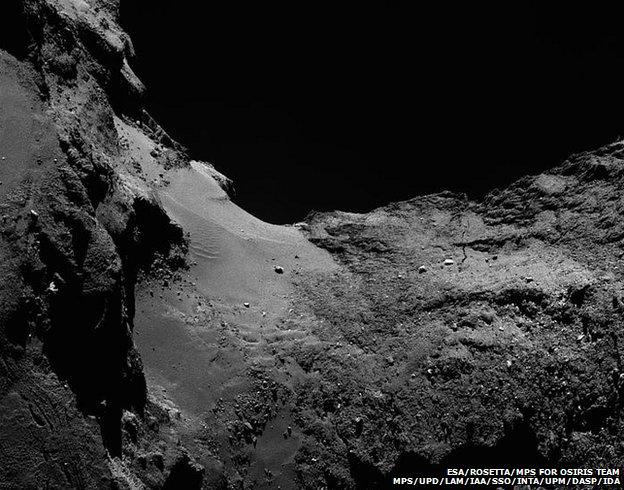
The mission has revealed an intriguing landscape on Comet 67P
One of Ptolemy's most significant discoveries, external is of a compound known as polyoxymethylene, a string of relatively simple molecules forming a polymer of formaldehyde.
Prof Wright said: "The simplest unit of this polymer is a single carbon, two hydrogens and a single oxygen, and this then repeats itself. That same ratio of elements occur in carbohydrates and sugars so it's very interesting and implicated in the biological cycle we have on Earth."
In a separate paper, external, Fred Goesmann and colleagues describe the 16 compounds found by their COSAC instrument, and their possible importance for the development of life.
Hydroxyethanal is "an efficient initiator in the prebiotic formation of sugars", they write.
And methanenitrile is "a key molecule in the prebiotic synthesis of amino acids and nucleobases and even offers an elegant pathway to sugars".
The authors conclude that the complexity of the comet's chemical makeup, and the presence of organics containing nitrogen, "imply that early solar system chemistry fosters the formation of prebiotic material in noticeable concentrations".
None of the papers suggests the presence of more sophisticated compounds such as amino acids - though further analysis of the findings may yield that.
'Hardware shop'
Professor Charles Cockell, director of the UK Astrobiology Centre, was not involved in the mission but told the BBC the results were "very significant".
"Finding simple organic compounds on a comet out there in space, showing us that they could have been delivered to the early Earth, early in the history of our planet, is tremendously exciting.
"It gives us better ideas about how those building blocks of life may have formed and where they may have come from.
"It confirms there is organic chemistry throughout the universe, that carbon-containing compounds, some of which are very complex, could be being formed on comets in our solar system."

The Rosetta craft is still orbiting 67P and took this image on 28 April
Prof Mark McCaughrean, the European Space Agency's senior science advisor, told BBC News: "Imagine you want to build a house and you go to a forest, where there are trees, mud and rocks. You could make a house out of that, but it would be hard work.
"Well, we've now discovered the comet is more like a hardware shop - lots of pre-made building blocks, like door frames, bricks etc. It gives you a head start.
"One of the big questions, though, is this material made on the comet? Or is it made first in space and then incorporated into the comet? We don't know the answer to that yet."
The data published today was gathered during Philae's chaotic landing on the comet. Ptolemy had been programmed to switch on ten minutes after touching down.
Prof Wright told the BBC: "The idea was we'd just have time for a sniff of the air - there was no great reason to do it, it was to check the instrument had survived landing, an insurance policy to get some data as soon as possible."
As things turned out, Philae did not anchor itself to its original landing zone but bounced back up which meant that Ptolemy's 'sniff' took place while the spacecraft was airborne.
Despite this, the instrument successfully got readings of whatever material had entered its vent pipe.
"We've just got a snapshot of some dust that was flying around as we landed but we've got some very significant data," Prof Wright said.
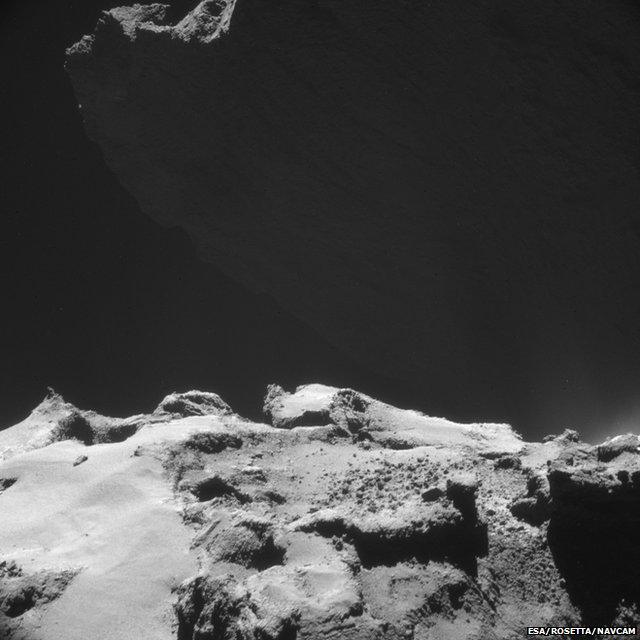
Scientists say the comet contains a kind of "frozen primordial soup"
After a long silence, the Philae lander made contact last month but the link has been intermittent and the spacecraft's fate is unclear.
One theory is that it may have been dislodged or tipped over by a jet of gas emerging from the rocks beneath it.
And gas jets are becoming more intense as the comet approaches the Sun - with its closest approach, known as perihelion, coming up shortly on 13 August.
Another idea is that because Philae is believed to be sitting at the foot of a cliff, it may have been hit by falling debris, dislodged as the surface warms.
But those involved in the mission are determined to remain optimistic that the lander has survived and will resume contact.
Even if it does not, several loads of data, collected and sent back in the Philae's first 60 hours on the comet, are still being analysed and have yet to be published.
- Published1 July 2015
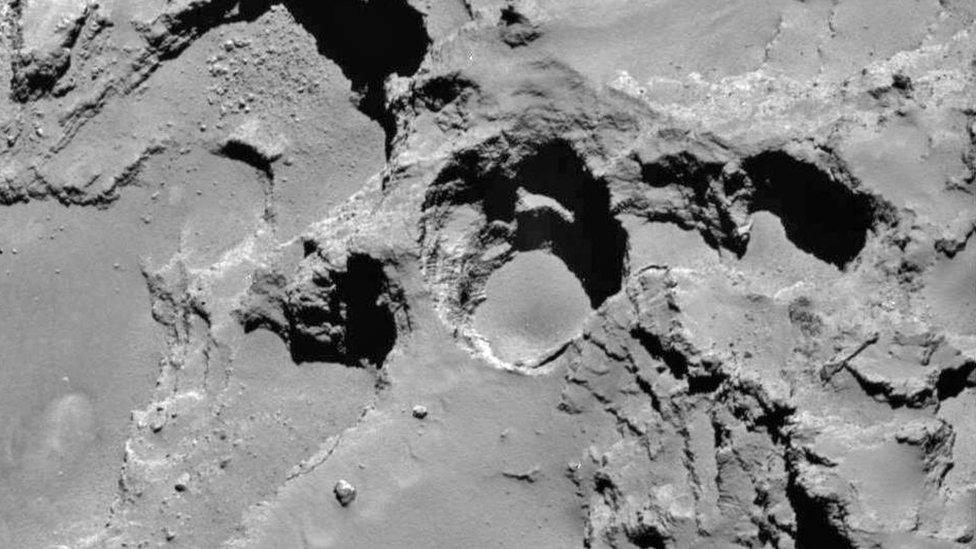
- Published19 June 2015

- Published14 June 2015
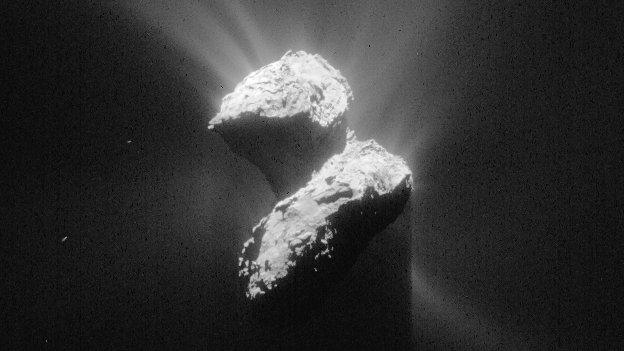
- Published14 April 2015
- Published18 November 2014
